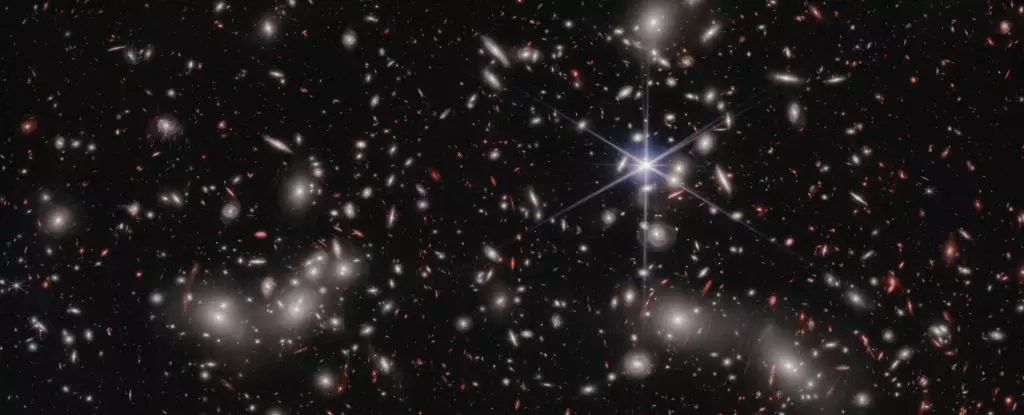In a groundbreaking revelation that significantly reshapes our understanding of cosmic history, data from the Hubble and James Webb Space Telescopes indicates that the earliest light in the universe was not born from massive galaxies or supermassive black holes, as previously believed, but from small dwarf galaxies. This strikingly different perspective not only illuminates the early universe’s evolution but also emphasizes the pivotal roles these seemingly insignificant cosmic entities play in shaping the celestial landscape.
Astrophysicist Iryna Chemerynska’s statement captures the essence of this discovery: ultra-faint galaxies wield a crucial influence during the epoch of cosmic reionization. For decades, scientists have wrestled with the enigmatic period that followed the Big Bang, during which ionized plasma rendered the universe in darkness. The study published in February 2024 reveals that dwarf galaxies’ production of ionizing photons was instrumental in transforming neutral hydrogen gas into ionized plasma, gradually clarifying the cosmic fog that engulfed the early universe.
The Transition from Darkness to Light
At the universe’s inception, within mere moments of the Big Bang, a hot, dense fog of ionized plasma saturated space. This early phase was characterized by extreme conditions where photons struggled to travel freely; they were continually scattered by free electrons, preventing any significant illumination. As the cosmos expanded and cooled over hundreds of thousands of years, protons and electrons began to combine, forming neutral hydrogen and a hint of helium.
Despite the presence of neutral hydrogen, the universe remained dim due to a lack of significant light sources. It wasn’t until the first stars ignited, galvanizing energy strong enough to reionize the gas, that the outlook changed. This monumental event marked the end of the cosmic darkness, enabling light to shine unfettered into the galaxies. By about one billion years post-Big Bang, a complete reionization had occurred, enabling a universe full of luminous, dynamic structures.
However, overcoming the obstacles of distance and time to study these early epoch phenomena has traditionally been challenging. Earlier hypotheses leaned towards the idea that massive galaxies or teeming black holes were the principal architects behind this cleansing of the cosmic fog. Yet, the advances brought by the James Webb Space Telescope challenge this notion, revealing a universe alive with far more dwarf galaxies than expected.
The Power of Dwarf Galaxies
An international team led by astrophysicist Hakim Atek leveraged the unique capabilities of the JWST and observational data from Hubble to focus on the galaxy cluster Abell 2744. This cluster, dense enough to warp space-time, provided the perfect lens to magnify light from distant sources, allowing researchers to delve deeper than ever before into the cosmic dawn. The analysis unveiled a surprising revelation—dwarf galaxies not only outnumber larger galaxies by an astonishing ratio of 100:1, but they also emit four times the ionizing radiation typically attributed to their larger counterparts.
Atek’s findings underscore a remarkable truth: the energy output from these petite galaxies is so prodigious that they collectively wield the power to transform the state of the early universe. These “cosmic powerhouses,” as described by Atek, are not simply passive players but pivotal contributors to the grand narrative of cosmic expansion and evolution.
Charting New Territory in Cosmic Research
While the study of these dwarf galaxies reveals monumental insights into the dynamics of the early universe, it also raises new questions about the methodology and scope of cosmic research. Atek and his team recognize that their findings are based on a limited patch of the sky. Therefore, additional studies across diverse cosmic lens regions will be crucial to ascertain whether these results genuinely represent a broader galactic population during this pivotal epoch.
The implications of this research resonate beyond sheer academic curiosity. Since the dawn of modern astronomy, scientists have grappled with the mystery of cosmic reionization, eager to understand what truly ignited the stars and illuminated the cosmic narrative. As Themiya Nanayakkara from Swinburne University of Technology states, “We have now entered uncharted territory with the JWST,” indicating that we may be on the threshold of a revolution in astronomy and astrophysics.
This exploration not only enhances our comprehension of galactic formation but also sheds light on the complex interplay of factors that contributed to the evolution of the universe. As researchers refine their techniques and expand their observational reach, the secrets of the cosmic dawn unravel, bringing us closer than ever to understanding the magnificent tapestry of the universe’s origins.

